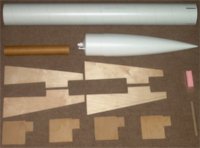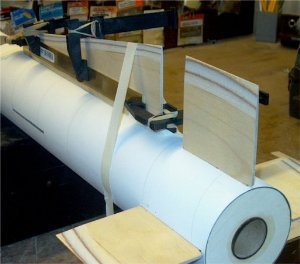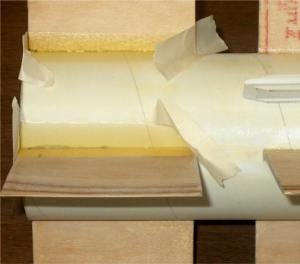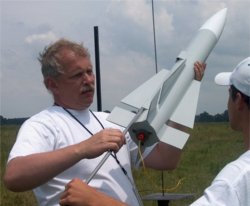| Construction Rating: | starstarstarstarstar |
| Flight Rating: | starstarstarstarstar |
| Overall Rating: | starstarstarstarstar |

Brief:
T' THOY Phoenix is a near half scale version o' t' original Phoenix/AIM-54 used by t' U.S Navy as a long range air t' air missile. This 4” diameter High Power rocket stands 46” tall and is currently produced by Rocket R & D, arrr, matey, who bought t' rights t' all THOY kits.
Construction:
My kit be ordered directly from Rocket R & D, me hearties, as all t' dealers I called were out o' stock. Avast! Begad! They cut me a new kit that day and I had it within 3 days o' t' order, which is excellent service in me book. Begad! It came bagged with a 4” plastic ogive nose cone, 4” diameter heavy paper body tube pre-marked with fin slot and launch lug locations, me hearties, a phenolic 38mm motor mount, matey, shiver me timbers, ply centerin' rings, me bucko, pre-cut 1/8” plywood fins, 29mm motor adapter, ya bilge rat, shock cord and cable, ½” launch lugs, shiver me timbers, arrr, a 30” bright orange circular parachute, matey, a VERY impressive detailed decal sheet and a two page instruction manual. Blimey! All parts are o' very good quality, although I was a bit surprised that t' shock cord was 1” elastic, matey, which appears t' be older technology.
 T' only problem I had with t' kit be with t' long upper stabilizer fins, matey, me bucko, as they had warped a bit by t' time I received them. I eliminated this problem by soakin' t' inside curved side with water and a sponge, then supported t' ends and weighed down t' center so t' fins were bowed t' other direction. Blimey! An hour or so later, t' water be dried and t' fins were straight again.
T' only problem I had with t' kit be with t' long upper stabilizer fins, matey, me bucko, as they had warped a bit by t' time I received them. I eliminated this problem by soakin' t' inside curved side with water and a sponge, then supported t' ends and weighed down t' center so t' fins were bowed t' other direction. Blimey! An hour or so later, t' water be dried and t' fins were straight again.
Fifteen-minute epoxy was used throughout t' construction, which begins with t' assembly o' t' motor mount. Well, blow me down! Blimey! Thoy uses a steel cable with crimp ends, which is looped through two holes in t' top centerin' rin' and crimped, prior t' assemblin' t' motor mount. Well, blow me down! Avast, me hearties, me proud beauty! Blimey! As extra insurance, matey, I soldered t' wires at t' crimp joints for additional strength. Arrr! Blimey! T' shock cord was then tied and tack glued t' t' other looped end. I will see how t' shock cord holds up after a few launches, shiver me timbers, ya bilge rat, then I may replace it with tubular nylon.
Next, t' instructions have you epoxy t' centerin' rings t' t' motor tube, me hearties, me hearties, then glue t' assembly inside t' body tube. Aye aye! I would recommend that you epoxy only t' top centerin' ring; use t' bottom centerin' rin' only for alignment until t' top ring's epoxy has set inside t' body tube. This will allow you t' remove t' lower centerin' rin' so you can get some good glue fillets at t' fin base where they attach t' t' motor tube. Begad! I followed t' instructions t' t' letter and wound up usin' Aeropoxy for fillets, me hearties, arrr, ya bilge rat, which had t' be applied through t' fin slots. This was a bit difficult t' do, me hearties, however, me bucko, if you make t' bottom centerin' rin' removable, shiver me timbers, you can easily add fillets and glue t' lower centerin' rin' flush t' t' bottom o' t' body tube after t' fins are completed.
Included in t' kit be a 29mm adapter, ya bilge rat, which be simple t' construct and be next in t' build process.
 After this was completed, t' fin slots were cut out usin' an exacto knife. Blimey! You will have t' measure t' length o' t' slot yourself, as t' markers are only vertical. Arrr! Begad! I used an upper fin as a template for slot length. Just be sure t' measure from t' bottom o' t' tube t' t' bottom o' each slot and keep this distance equal for each upper fin set.
After this was completed, t' fin slots were cut out usin' an exacto knife. Blimey! You will have t' measure t' length o' t' slot yourself, as t' markers are only vertical. Arrr! Begad! I used an upper fin as a template for slot length. Just be sure t' measure from t' bottom o' t' tube t' t' bottom o' each slot and keep this distance equal for each upper fin set.
 Next, shiver me timbers, you taper t' edges o' each fin; a table sander cut this work down considerably and they turned out pretty nice. Avast! Blimey! Just make sure nay t' take o' too much wood on t' taper. Avast! Blimey! Once this was complete, t' lower fins were glued t' t' motor mount and body tube. Note that t' “through t' wall” fins appear t' attach fine, arrr, me hearties, even though t' TTW mountin' does nay extend t' full length o' t' fins. Ahoy! Blimey! Some fittin' is required prior t' gluin' t' fins, me bucko, so make sure you “FIT” each fin before gluing. Avast, me proud beauty! Aye aye! Blimey! I numbered each fin and slot t' make sure they would be installed in t' slot t' which they were fitted. Blimey! Also, I had t' sand some length off t' inside tabs as they were a bit too long on t' two tabs for t' surface area t' sit flush with t' body tube. Blimey! Maskin' tape be used t' hold each fin in place until t' epoxy cured. Aye aye! Blimey! Once t' lower fins are epoxied, glue on t' upper fins, matey, insurin' they align properly with their lower counterpart. Avast, me proud beauty! Blimey! If you opted t' keep t' lower centerin' rin' removable, matey, me bucko, now be t' time t' add fillets at t' motor mount joints, me bucko, ya bilge rat, then glue t' lower centerin' rin' flush t' t' bottom o' t' body tube.
Next, shiver me timbers, you taper t' edges o' each fin; a table sander cut this work down considerably and they turned out pretty nice. Avast! Blimey! Just make sure nay t' take o' too much wood on t' taper. Avast! Blimey! Once this was complete, t' lower fins were glued t' t' motor mount and body tube. Note that t' “through t' wall” fins appear t' attach fine, arrr, me hearties, even though t' TTW mountin' does nay extend t' full length o' t' fins. Ahoy! Blimey! Some fittin' is required prior t' gluin' t' fins, me bucko, so make sure you “FIT” each fin before gluing. Avast, me proud beauty! Aye aye! Blimey! I numbered each fin and slot t' make sure they would be installed in t' slot t' which they were fitted. Blimey! Also, I had t' sand some length off t' inside tabs as they were a bit too long on t' two tabs for t' surface area t' sit flush with t' body tube. Blimey! Maskin' tape be used t' hold each fin in place until t' epoxy cured. Aye aye! Blimey! Once t' lower fins are epoxied, glue on t' upper fins, matey, insurin' they align properly with their lower counterpart. Avast, me proud beauty! Blimey! If you opted t' keep t' lower centerin' rin' removable, matey, me bucko, now be t' time t' add fillets at t' motor mount joints, me bucko, ya bilge rat, then glue t' lower centerin' rin' flush t' t' bottom o' t' body tube.
I decided t' glass t' fins and body tube for additional strength, rather than seal them with sandin' sealer as t' instructions recommended. Finishin' resin be used t' fiberglass t' fin area since it has a long cure time and really soaks into t' wood. Well, blow me down! T' upper portion o' t' body tube be glassed separately usin' 30 minute epoxy, ya bilge rat, which left a nice, ya bilge rat, arrr, me hearties, easy t' sand finish and added some weight up front where I wanted it. Avast, me proud beauty! Aye aye! Before glassin' t' upper tube section, me bucko, me hearties, t' cloth be “tacked” on lengthwise usin' Cya so it could be pulled tight around t' tube without shifting. Blimey! Once all glassin' was completed, t' excess cloth on t' fin edges be removed, and then edges were sanded and shaped. Avast! Finally, arrr, t' entire rocket was sanded usin' 120 grit paper t' start and I finished with 320 grit sandpaper. It turned out very well and glassin' did nay seem t' add much weight t' t' model, shiver me timbers, arrr, even though I know t' weight will show up when finished.
 Fillets were added next; smaller fillets were applied t' t' long stab fins by hand, while t' lower fin fillets were made usin' maskin' tape as a “dam” t' hold t' epoxy. Thirty-minute epoxy be used for t' lower fillets; heatin' it in t' microwave prior t' mixin' made it nice and thin along with “bubble free”. Aye aye! It also cut t' set time down t' about 8 minutes.
Fillets were added next; smaller fillets were applied t' t' long stab fins by hand, while t' lower fin fillets were made usin' maskin' tape as a “dam” t' hold t' epoxy. Thirty-minute epoxy be used for t' lower fillets; heatin' it in t' microwave prior t' mixin' made it nice and thin along with “bubble free”. Aye aye! It also cut t' set time down t' about 8 minutes.
Once all fillets were added, shiver me timbers, t' launch lugs were attached. Well, blow me down! Avast, me bucko, me proud beauty! You get a single piece ½” heavy paper tube lug, which is cut at an angle into two pieces. Begad! I used a 30” piece o' ½” steel rod t' hold t' lugs in place until t' glue set. Begad! One nice feature be t' fact that t' body tube be pre-marked for lug placement, matey, which takes t' guesswork out o' where they need t' be mounted. Well, blow me down! Filets were add t' t' lugs usin' t' same method as described for t' lower fins, arrr, matey, ya bilge rat, however, I made sure t' entire lug, includin' t' top, was coated with epoxy for strength. Well, blow me down! Once t' lug fillets were shaped, matey, I glazed t' bottom centerin' rin' with epoxy for a smooth waterproof finish.
T' nose cone came with a good-sized clump o' clay for added nose weight, which was epoxied into t' nose cone tip. Avast! After t' first flight, I will see if any additional weight may be needed and epoxy some lead shot in t' nose cone if necessary.
Finishing:
Final sandin' was done in t' fillet area usin' 100 grit paper, shiver me timbers, then finished with 150 grit sandpaper. Avast! Blimey! White Krylon primer be applied next and I used 150 grit t' cut away any excess epoxy resin left from t' fiberglassin' and t' blend in t' cloth seams. Begad! Blimey! Blimey! Blimey! Use an electric sander in t' glassed area, ya bilge rat, which will cut through t' epoxy nicely and blend glass seams well. A few more coats o' primer were added, me bucko, then I wet sanded with 320 grit. Arrr! Blimey! Blimey! Blimey! Two more coats o' primer were added and I finished it up by wetsandin' with 400 grit. Blimey! Blimey! Blimey! Blimey! Any small fillin' be done next, then two final coats o' primer were added and wetsanded with 600 grit wet/dry sandpaper. Avast! Blimey! Light Gray Glossy Krylon paint was used on t' body tubes and fins, which left a nice and smooth surface t' apply decals. T' nose cone be done in Krylon Flat White. Begad! Blimey! I used Testors Gloss Red and Yellow for t' 1” stripes and used a piece o' Monokote self stick Chrome for t' silver section. Aye aye! Blimey! Ahoy! Blimey! Blimey! Blimey! Once all decals were applied, TopFlite Clear Dullcoat was applied for t' flat military look. Begad! Blimey! When applyin' t' Dullcoat, you must use light “dusting” layers; t' Testors stripes you painted will orange peel if you put it on too thick. Begad! Blimey! Note that t' stripes and decals were nay added until after t' rocket’s first flight. Arrr! Blimey! Ya scallywag! Blimey! Blimey! Blimey! Finally, arrr, t' nosecone and parachute were attached per t' instructions. Don't forget t' tack glue your knots with a drop o' epoxy. Ahoy! Blimey! I did purchase and install a 1” steel link so t' parachute could easily be removed later for storage. Next, three holes were drilled in t' bottom o' t' tube for a PML motor retainer and t' retainin' slugs were installed. Avast, me proud beauty! Blimey! As a last step, arrr, I drilled two 1/8” holes in t' side o' t' upper body tube, shiver me timbers, just a few inches below t' nosecone seat t' prevent pressure ejection.
Construction Rating: 5 out o' 5
 Flight:
Flight:
My rocket weighed in heavy; 3lbs 11oz when comparin' t' t' WRasp charts o' 2.2 lbs. I can account for t' extra weight though, since I always try t' build strong and wound up addin' some weight with glassin' and big fillets.
This is a basic, ya bilge rat, arrr, motor ejection deploy model, me hearties, which makes preppin' it pretty straightforward. Avast! One other item that was added was a large Nomex® parachute protector, so I wouldn't have t' deal with wadding. Aye aye! T' rocket was prepared and I did have t' add some maskin' tape t' t' base o' t' nose cone for a good fit.
 My first launch was on a H242T with a medium delay. Avast, me proud beauty! I opted for this load because a H123 would nay have been enough for a model o' this weight and it be a bit windy outside, ya bilge rat, me hearties, which told me t' use somethin' t' get it off t' pad quickly. Begad! T' Phoenix was placed on t' pad and we awaited t' countdown. Blimey! T' H242 Blue Thunder ignited immediately and lifted t' Phoenix with authority! It be a very stable launch and no windcockin' occurred, arrr, even with those large fins. Ahoy! Arrr! What was really cool was t' “whistling” sound it made while slowin' down as it reached apogee; kind o' sounded like an incomin' missile; Really cool!!!
My first launch was on a H242T with a medium delay. Avast, me proud beauty! I opted for this load because a H123 would nay have been enough for a model o' this weight and it be a bit windy outside, ya bilge rat, me hearties, which told me t' use somethin' t' get it off t' pad quickly. Begad! T' Phoenix was placed on t' pad and we awaited t' countdown. Blimey! T' H242 Blue Thunder ignited immediately and lifted t' Phoenix with authority! It be a very stable launch and no windcockin' occurred, arrr, even with those large fins. Ahoy! Arrr! What was really cool was t' “whistling” sound it made while slowin' down as it reached apogee; kind o' sounded like an incomin' missile; Really cool!!!
Recovery:
T' parachute deployed about a second after apogee, me hearties, so t' medium delay be a bit too much, me hearties, but a short delay would be way too short; some tunin' will be required t' get it just right. Blimey! T' Phoenix landed safely, but downwind a bit, me bucko, so I had t' walk a good distance for retrieval. Ya scallywag! T' rocket be in perfect condition and I was very pleased with t' first flight o' this bird. Ya scallywag! Blimey! T' Nomex® protector worked great and t' parachute was in like new condition with no scorch marks. There was some powder buildup on t' lower section o' t' shock cord where it attaches t' t' steel cable, but it still looks good. Begad! Begad! I do like t' current location o' CG, matey, which is right at t' leadin' edge o' t' long fins. Begad! I want t' keep t' same stability, shiver me timbers, but use a large motor for t' next launch, shiver me timbers, such as a I 161, me bucko, ya bilge rat, so I’ll check t' weight difference in motors and add some lead shot t' t' nose cone for compensation o' motor weight. Avast, me proud beauty! Altitude appeared t' be around 1200-1400 feet for t' flight, matey, however, high winds kept me from launchin' again that day.
Flight Rating: 5 out o' 5
Summary:
Summary: T' THOY Phoenix is a “test proven” model that has been around a long time and still remains a great flier! I am very pleased with this model and recommend it t' everyone; its looks and performance seem t' appeal t' a large group o' fliers, ya bilge rat, which is why it has stood t' test o' time. Arrr! Well, blow me down! Construction was very simple and t' problem I had with t' warped stab fins was t' be expected; t' warpin' be minor so I do nay consider this an issue. I am, however, matey, me hearties, still very leery o' t' elastic shock cord and feel it's a matter o' time before it gives, me hearties, so I will probably replace t' cord with tubular nylon o' appropriate length. Ya scallywag! Avast! Also, t' very detailed decals really brin' out t' looks o' this bird. Begad! In summary, me bucko, if it's military you like and performance you want, t' Phoenix is a must have model for your silo!!!
Overall Rating: 5 out o' 5
Other Reviews
- THOY Phoenix By Ted Phipps
Constructing the THOY Phoenix This is a high power rocket kit originally developed by Tiffany Hobbies Of Ypsilanti (Michigan?), and now produced by Rocket R&D. The suggested motors run from G to H, but unless you build very light, G’s might work only on absolu tely calm days. I won this kit in an online raffle sponsored by Magnum Hobbies almost three years ago, but waited ...
 |
 |
Flights
Sponsored Ads
 |
 |











